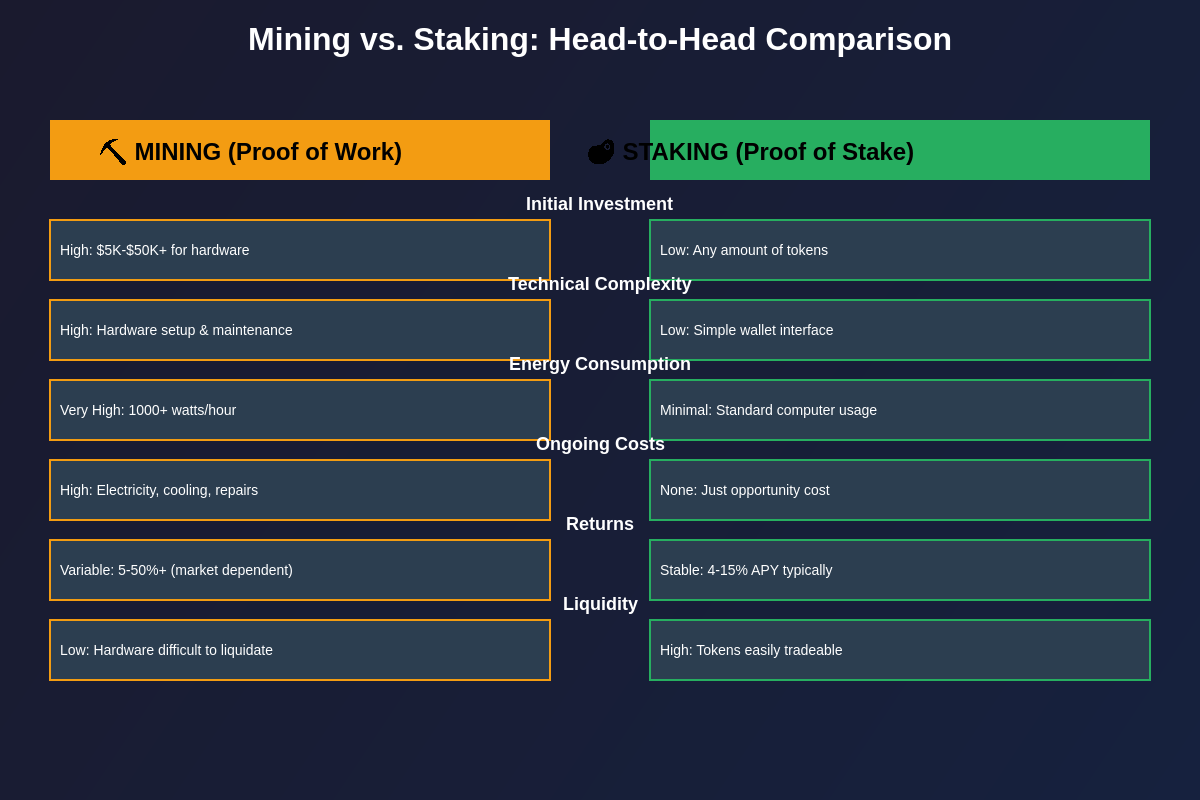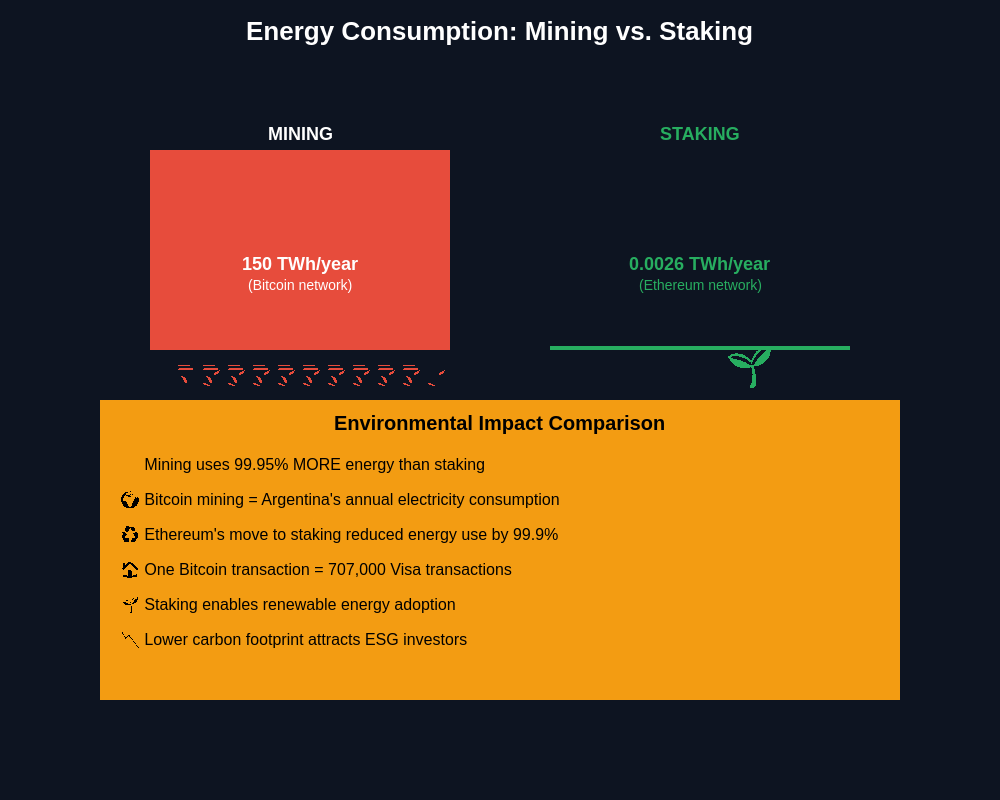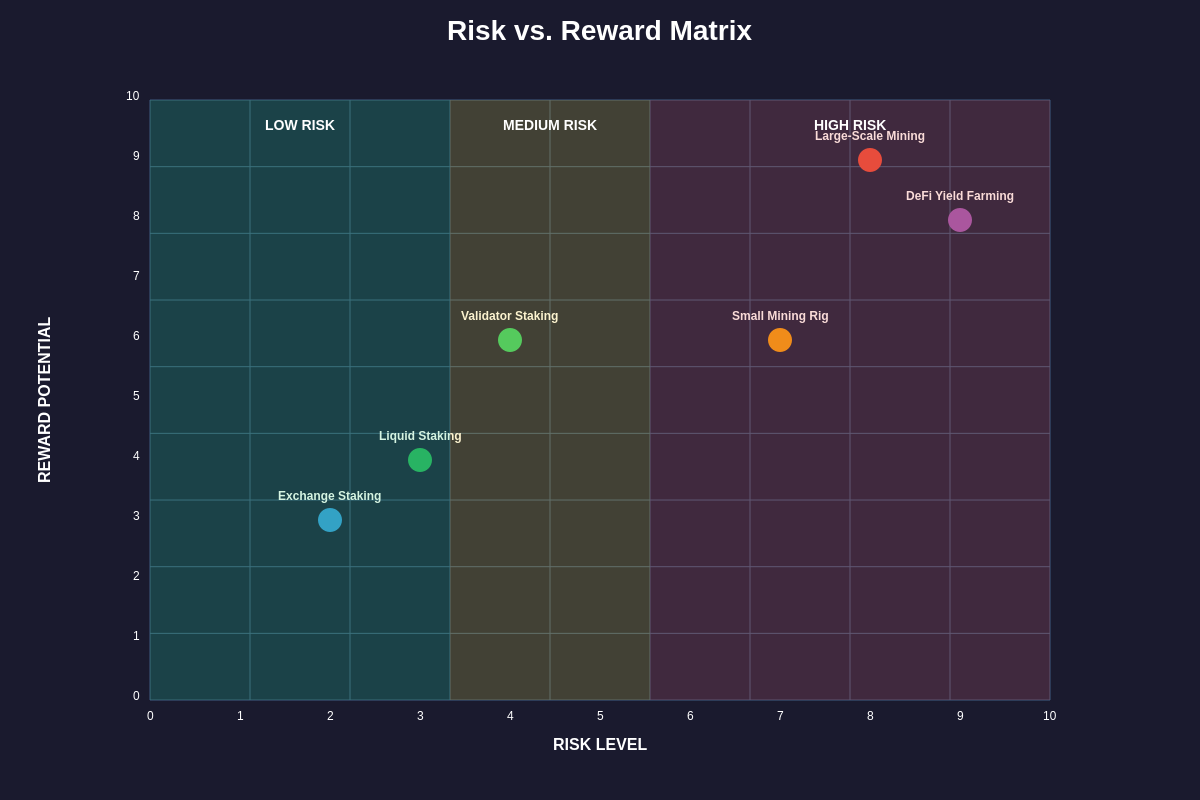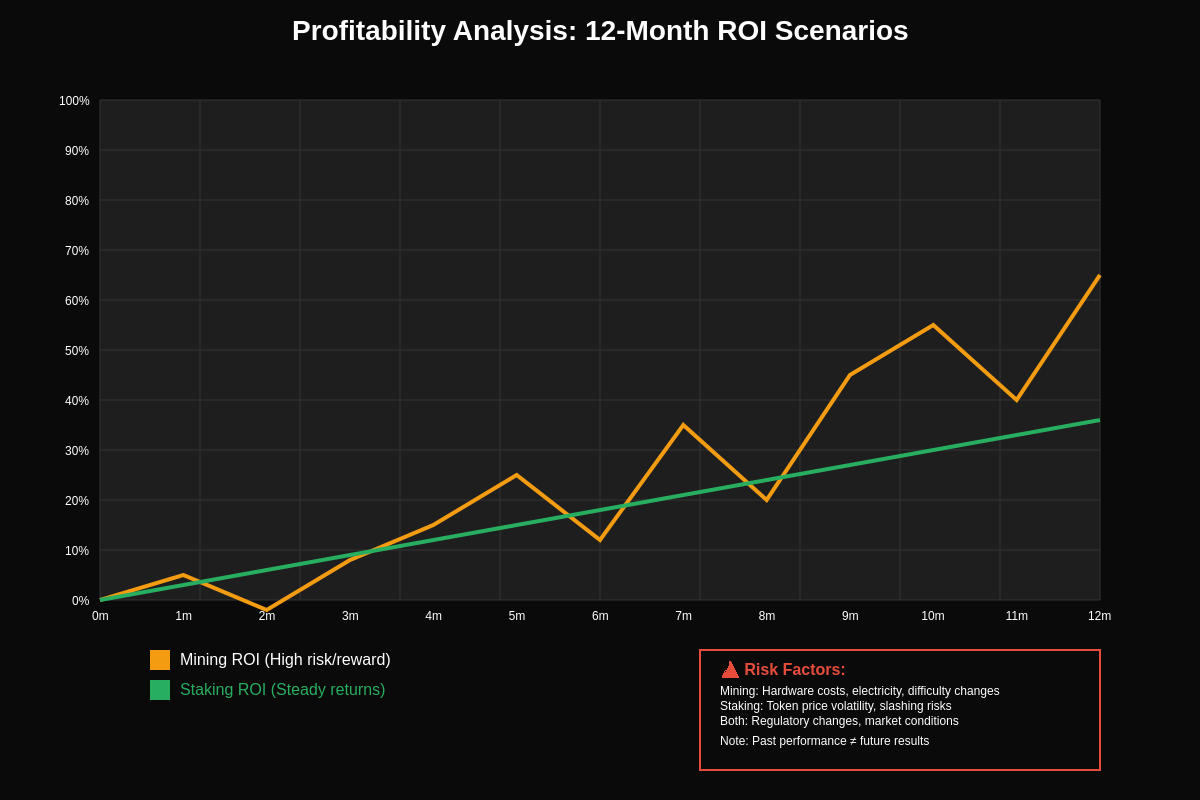TradingView Pine Script Reference provides comprehensive tools for analyzing cryptocurrency mining and staking profitability through advanced charting and technical analysis capabilities.
The Evolution of Blockchain Consensus Mechanisms
The cryptocurrency landscape has undergone a fundamental transformation in how blockchain networks achieve consensus and secure their operations, with two primary mechanisms emerging as dominant forces in the ecosystem. Mining, the original consensus mechanism pioneered by Bitcoin, relies on computational power and energy consumption to validate transactions and create new blocks, while staking represents a more recent innovation that uses economic incentives and token ownership to achieve the same security objectives with significantly different resource requirements and operational characteristics.

Understanding the fundamental differences between these two approaches requires examining not only their technical implementations but also their economic implications, environmental impact, and accessibility for different types of participants. Both mechanisms serve the essential function of maintaining blockchain security and decentralization while providing participants with opportunities to earn rewards for their contributions to network operations, yet they achieve these goals through vastly different methodologies that appeal to different investor profiles and risk tolerances.
The choice between staking and mining extends beyond simple profitability calculations to encompass considerations of technical complexity, capital requirements, ongoing operational demands, and alignment with personal values regarding environmental sustainability. As the cryptocurrency industry continues to mature and evolve, the relative advantages and disadvantages of each approach become increasingly important for participants seeking to optimize their involvement in blockchain networks while managing risk and maximizing long-term returns.
Understanding Cryptocurrency Mining
Cryptocurrency mining represents the foundational consensus mechanism that secured the first generation of blockchain networks and continues to power some of the most valuable cryptocurrencies in existence today. The mining process involves specialized computer hardware competing to solve complex mathematical problems, with successful miners receiving newly created cryptocurrency tokens as rewards for their computational contributions to network security and transaction validation.
The technical infrastructure required for profitable mining operations has evolved dramatically since Bitcoin’s early days when individuals could mine effectively using standard desktop computers. Modern mining requires significant investments in specialized hardware, including Application-Specific Integrated Circuits (ASIC) miners for Bitcoin and other SHA-256 algorithms, or high-performance Graphics Processing Units (GPU) for algorithms like Ethereum’s former Ethash or current alternatives such as Ethereum Classic and Ravencoin.
Historical cryptocurrency mining data demonstrates the evolution of mining difficulty and profitability over time, showing how increasing network participation and hardware efficiency have affected individual mining returns.
The economics of mining operations involve complex calculations balancing hardware costs, electricity expenses, cooling requirements, and maintenance needs against potential cryptocurrency rewards and their fluctuating market values. Successful mining operations require careful attention to electricity rates, as power consumption typically represents the largest ongoing operational expense, with industrial-scale operations often relocating to regions with abundant renewable energy or favorable regulatory environments.
Mining pool participation has become essential for most individual miners, as the increasing difficulty of mining algorithms makes solo mining impractical for all but the largest operations. Mining pools aggregate the computational power of multiple participants, distributing rewards proportionally based on contributed hashrate while providing more consistent and predictable income streams compared to the high variance of solo mining attempts.
The environmental impact of mining operations has become a significant consideration for both participants and regulators, with proof-of-work networks consuming substantial amounts of electricity. This has led to increased focus on renewable energy sources for mining operations and ongoing debates about the sustainability of energy-intensive consensus mechanisms in an era of growing environmental consciousness.
Exploring Cryptocurrency Staking
Cryptocurrency staking represents a paradigm shift in how blockchain networks achieve consensus and distribute rewards, offering participants the opportunity to earn passive income by holding and locking cryptocurrency tokens rather than dedicating computational resources to complex mathematical calculations. This proof-of-stake mechanism has gained tremendous popularity due to its lower barriers to entry, reduced environmental impact, and the potential for more predictable returns compared to traditional mining operations.
The fundamental concept behind staking involves token holders depositing their cryptocurrency into network validators or staking pools, effectively using their economic stake in the network as collateral to participate in transaction validation and block production. Validators are chosen to create new blocks based on factors including their total stake, randomization algorithms, and network-specific selection criteria, with rewards distributed proportionally to staking participants based on their contributed tokens and the duration of their commitment.
Ethereum staking rewards analysis provides insights into the yield dynamics and market impact of major proof-of-stake networks, helping participants understand historical returns and market conditions.
Different staking models offer varying levels of flexibility and reward potential, ranging from liquid staking protocols that allow participants to maintain token liquidity while earning rewards, to locked staking arrangements that require token commitments for fixed periods in exchange for higher yield rates. Delegated proof-of-stake systems enable token holders to delegate their staking power to professional validators while retaining ownership of their tokens, creating opportunities for passive participation without the technical requirements of running validator infrastructure.
The technical requirements for staking are generally much lower than mining, with many staking opportunities accessible through cryptocurrency exchanges, dedicated staking platforms, or simple wallet applications. However, participants should understand the risks associated with staking, including potential slashing penalties for validator misbehavior, smart contract risks in liquid staking protocols, and the opportunity cost of locking tokens during volatile market conditions.
Staking yields vary significantly across different networks and staking methods, influenced by factors such as total network participation, inflation rates, transaction fee revenue, and network-specific reward mechanisms. Understanding these variables is crucial for making informed decisions about staking allocation and choosing between different staking opportunities that align with individual risk tolerance and return expectations.
Comparative Analysis: Capital Requirements and Accessibility
The capital requirements for participating in mining versus staking operations differ dramatically in both scale and nature, creating distinct accessibility profiles that appeal to different types of cryptocurrency investors and participants. Mining operations typically require substantial upfront investments in specialized hardware, with entry-level ASIC miners costing several thousand dollars and professional-grade mining rigs representing investments of tens of thousands of dollars or more, before considering additional infrastructure costs for power distribution, cooling systems, and facility requirements.
Staking, by contrast, offers much more flexible capital requirements with minimum staking amounts varying from essentially zero for exchange-based staking to modest token holdings for most proof-of-stake networks. Ethereum 2.0 staking requires a minimum of 32 ETH for solo staking, but liquid staking protocols and staking pools enable participation with any amount of tokens, democratizing access to staking rewards regardless of individual wealth levels.
The ongoing capital commitments also differ significantly between the two approaches, with mining requiring continuous electricity payments, hardware maintenance costs, and eventual equipment replacement as technology advances and mining difficulty increases. These ongoing expenses create operational leverage that can amplify both profits during favorable conditions and losses during periods of low cryptocurrency prices or high electricity costs.
Staking participants face different types of ongoing considerations, including the opportunity cost of locked tokens, potential impermanent loss in liquid staking protocols, and the risk of slashing penalties in some proof-of-stake networks. However, these risks are generally more predictable and manageable compared to the operational complexities and variable costs associated with mining operations.
The scalability of operations also presents different characteristics, with mining operations potentially benefiting from economies of scale in electricity procurement, hardware purchasing, and operational efficiency, while staking returns typically scale linearly with the amount of tokens staked, regardless of the size of individual positions.
Geographic considerations play a crucial role in mining accessibility, as electricity costs and regulatory environments vary dramatically across different regions, potentially excluding participants in areas with high energy costs or restrictive regulations. Staking accessibility is primarily limited by internet connectivity and regulatory considerations regarding cryptocurrency ownership rather than physical infrastructure requirements.
Energy Consumption and Environmental Impact
The environmental implications of mining versus staking represent one of the most significant differentiating factors between these two consensus mechanisms, with profound implications for both individual participants and the broader cryptocurrency ecosystem. Bitcoin mining alone consumes electricity comparable to entire countries, leading to intense scrutiny from environmental advocates, regulators, and sustainability-conscious investors who are increasingly factoring carbon footprint considerations into their investment decisions.

Proof-of-work mining’s energy consumption stems from its fundamental security model, which relies on making attacks economically prohibitive through the requirement of massive computational effort. This design creates an inherent link between network security and energy consumption, with more secure networks generally requiring more electricity to maintain their hash rates and resistance to potential attacks.
The carbon intensity of mining operations varies dramatically based on the energy sources used, with operations powered by renewable energy sources such as hydroelectric, solar, or wind power having significantly lower environmental impacts than those relying on fossil fuel generation. Many mining companies have begun prioritizing renewable energy sources and carbon offset programs in response to environmental concerns and ESG investment criteria.
Staking mechanisms eliminate the energy-intensive computational requirements of proof-of-work systems, typically reducing network energy consumption by over 99% compared to equivalent proof-of-work networks. Ethereum’s transition from mining to staking, known as “The Merge,” demonstrated this dramatic reduction in environmental impact while maintaining network security and functionality.
The environmental benefits of staking extend beyond direct energy consumption to include reduced electronic waste from mining hardware obsolescence, lower cooling requirements, and decreased infrastructure demands for large-scale operations. These factors contribute to a more sustainable model for blockchain network operation that aligns with growing corporate and individual sustainability commitments.
However, the environmental impact of staking is not entirely negligible, as validator operations still require computer hardware and internet connectivity, and the economic incentives of staking can indirectly influence energy consumption through increased cryptocurrency adoption and trading activity. Nevertheless, the environmental footprint of staking remains orders of magnitude lower than comparable mining operations.
Technical Complexity and Operational Requirements
The technical demands of mining and staking operations vary significantly in both complexity and the types of expertise required for successful implementation, creating different barriers to entry and ongoing operational challenges for participants. Mining operations require substantial technical knowledge encompassing hardware selection, firmware optimization, cooling system design, electrical infrastructure, and ongoing maintenance procedures that can be daunting for newcomers to cryptocurrency.
Successful mining operations demand expertise in areas including ASIC miner configuration, GPU overclocking and undervolting, mining pool selection and optimization, hardware troubleshooting, and facility management. Large-scale mining operations additionally require knowledge of industrial electrical systems, HVAC design, fire suppression systems, and compliance with local building codes and electrical regulations.
The ongoing operational requirements of mining include continuous monitoring of hardware performance, temperature management, firmware updates, pool connectivity, and profitability analysis as network difficulty and cryptocurrency prices fluctuate. Equipment failures, power outages, and overheating issues can significantly impact mining profitability and require prompt attention to minimize downtime and potential hardware damage.
Staking operations generally require much less technical expertise, with many staking opportunities accessible through user-friendly interfaces provided by cryptocurrency exchanges, wallet applications, or staking platforms. Basic staking participation often requires only the ability to transfer tokens to a staking contract or delegate tokens to a validator through a simple web interface.
More advanced staking operations, such as running independent validators, require moderate technical skills including server administration, blockchain node operation, and understanding of network-specific staking protocols. However, these requirements are typically less demanding than mining operations and can often be managed through cloud-based infrastructure without requiring physical hardware maintenance.
Technical analysis tools for mining and staking profitability help participants track performance metrics and make informed decisions about their operations.
The troubleshooting and maintenance requirements for staking are generally limited to ensuring validator uptime, maintaining network connectivity, and monitoring for slashing conditions or other network-specific issues. Most staking problems can be resolved through software updates or configuration changes rather than hardware replacement or repair.
Risk Assessment and Reward Potential
The risk profiles associated with mining and staking operations encompass different categories of potential losses and uncertainties that participants must carefully evaluate when choosing between these approaches. Mining risks include hardware obsolescence as new, more efficient equipment enters the market, making existing miners less competitive or entirely unprofitable, while also facing potential equipment failure, theft, or damage that can result in significant capital losses.

Market volatility affects both mining and staking operations but in different ways, with mining profitability subject to the relationship between cryptocurrency prices and mining difficulty adjustments, creating scenarios where miners may operate at losses during prolonged bear markets. The high fixed costs of mining operations, including electricity and facility expenses, create operational leverage that amplifies both gains during favorable conditions and losses during challenging periods.
Regulatory risks impact mining and staking differently, with mining operations potentially subject to restrictions based on energy consumption, environmental regulations, or local zoning laws, while staking faces primarily securities regulation considerations and potential restrictions on cryptocurrency ownership or operation of validator services.
Staking risks include slashing penalties for validator misbehavior, smart contract risks in liquid staking protocols, and the opportunity cost of locked tokens during volatile market conditions. The validator selection process in proof-of-stake networks can also affect rewards, with poorly performing validators potentially reducing overall returns for delegated stakers.
The reward potential for both approaches varies significantly based on market conditions, network participation levels, and operational efficiency. Mining rewards are generally more volatile and subject to difficulty adjustments, while staking rewards tend to be more predictable but potentially lower on an absolute return basis during favorable mining conditions.
Diversification considerations differ between mining and staking, with mining operations typically focused on specific algorithms or cryptocurrencies based on hardware compatibility, while staking allows for easier diversification across multiple proof-of-stake networks with lower switching costs and capital requirements.
Long-term sustainability risks include the potential obsolescence of proof-of-work networks as environmental concerns drive adoption of more energy-efficient alternatives, while staking faces risks related to network governance, protocol changes, and the evolution of staking mechanisms that could affect future reward structures.
Profitability Analysis and ROI Considerations
Determining the profitability of mining versus staking requires comprehensive analysis of multiple variables that influence returns over different time horizons, with both approaches offering distinct risk-return profiles that appeal to different investment strategies and market conditions. Mining profitability calculations must account for hardware depreciation, electricity costs, maintenance expenses, and the volatile relationship between cryptocurrency prices and network hash rates that determine individual mining rewards.

The break-even analysis for mining operations involves complex calculations considering initial hardware investments, ongoing operational costs, and projected cryptocurrency rewards over the expected lifespan of mining equipment. These calculations become more challenging due to the unpredictable nature of mining difficulty adjustments, which occur regularly to maintain consistent block times as network hash rate fluctuates with miner participation and hardware efficiency improvements.
Staking profitability analysis tends to be more straightforward, focusing primarily on staking yields, token price appreciation potential, and the opportunity cost of locked tokens compared to alternative investment opportunities. The more predictable nature of staking rewards allows for clearer ROI projections, though participants must still account for network-specific risks such as slashing penalties and validator performance variations.
Cryptocurrency profitability calculators and charts provide essential tools for comparing mining and staking returns across different networks and market conditions.
The time horizon for profitability differs significantly between mining and staking, with mining operations typically requiring longer payback periods due to substantial upfront hardware investments, while staking can begin generating returns immediately upon token commitment. This difference in capital recovery timeframes affects the overall risk profile and suitability for different investor preferences and financial situations.
Tax implications also vary between mining and staking rewards, with mining typically treated as business income subject to self-employment taxes and equipment depreciation schedules, while staking rewards may be classified differently depending on jurisdiction and specific circumstances. Understanding these tax consequences is essential for accurate profitability analysis and compliance with applicable regulations.
Market timing considerations affect both approaches but in different ways, with mining profitability highly sensitive to the relationship between cryptocurrency prices and mining difficulty, while staking returns are more directly correlated with token price movements and network participation levels. The ability to time entry and exit from these activities varies significantly, with mining requiring more lead time for equipment procurement and setup.
Choosing the Right Approach for Your Situation
Selecting between mining and staking requires careful evaluation of personal circumstances, risk tolerance, technical capabilities, and investment objectives that align with the distinct characteristics of each approach. Individual factors such as available capital, electricity costs, technical expertise, time commitment preferences, and environmental values all play crucial roles in determining which method offers the best fit for specific situations and goals.
Investors with substantial capital, access to low-cost electricity, and willingness to manage complex technical operations may find mining attractive, particularly if they can achieve economies of scale through larger operations or have access to specialized knowledge that provides competitive advantages. The potential for higher returns during favorable market conditions and the ability to switch between different mining algorithms based on profitability can appeal to more active and technically sophisticated participants.
Those prioritizing simplicity, lower capital requirements, environmental sustainability, and more predictable returns may gravitate toward staking opportunities that offer passive income generation without the operational complexities of mining. The flexibility to stake various cryptocurrencies and adjust positions based on market conditions provides staking participants with diversification options that may be more difficult to achieve with mining operations.
Risk tolerance plays a crucial role in this decision, with mining offering potentially higher returns but also greater operational risks, hardware obsolescence concerns, and sensitivity to electricity costs and regulatory changes. Staking provides more predictable returns with different risk factors including smart contract risks, slashing penalties, and opportunity costs of locked tokens.
Geographic considerations significantly impact the viability of mining operations, with participants in regions with high electricity costs or restrictive regulations potentially finding staking more accessible and profitable. Staking accessibility depends primarily on internet connectivity and cryptocurrency ownership regulations rather than physical infrastructure requirements.
The investment time horizon also influences the optimal choice, with mining typically requiring longer commitment periods to recover hardware investments, while staking offers more flexibility for shorter-term positions or dynamic allocation strategies based on changing market conditions and opportunity sets.
Portfolio diversification strategies may favor combining both approaches or emphasizing one based on existing investment allocations and overall portfolio objectives. Some participants choose to start with staking to gain experience and generate initial returns before potentially expanding into mining operations as their knowledge and capital grow.
Future Outlook and Industry Trends
The trajectory of mining and staking within the broader cryptocurrency ecosystem continues to evolve rapidly, with technological advances, regulatory developments, and market dynamics shaping the relative attractiveness and viability of each approach. The ongoing transition of major blockchain networks from proof-of-work to proof-of-stake mechanisms, exemplified by Ethereum’s successful merge, signals a broader industry shift toward more energy-efficient consensus mechanisms that could significantly impact the long-term prospects for mining operations.
Technological innovations in mining hardware continue to drive efficiency improvements, but the rate of advancement has slowed compared to earlier periods, while simultaneously increasing the capital requirements for competitive mining operations. The development of more efficient ASIC miners and improved cooling technologies helps maintain mining profitability, but these advances often require substantial investments that may be beyond the reach of smaller-scale operations.
Staking infrastructure continues to mature with the development of more sophisticated liquid staking protocols, improved validator selection mechanisms, and enhanced user interfaces that make staking more accessible to mainstream cryptocurrency investors. The integration of staking services into major cryptocurrency exchanges and financial platforms has significantly reduced the technical barriers to staking participation.
Regulatory developments increasingly favor energy-efficient blockchain networks, with some jurisdictions implementing restrictions on high-energy cryptocurrency mining while supporting proof-of-stake networks. These regulatory trends may accelerate the shift toward staking mechanisms and create additional challenges for mining operations in certain regions.
The emergence of hybrid consensus mechanisms and innovative approaches such as delegated proof-of-stake, nominated proof-of-stake, and other variations continues to expand the options available to cryptocurrency networks and their participants. These developments may create new opportunities that combine elements of both mining and staking while addressing some of the limitations of traditional approaches.
Environmental, social, and governance (ESG) considerations continue to gain prominence in investment decision-making, potentially favoring staking mechanisms that align with sustainability goals and corporate responsibility initiatives. This trend may drive institutional adoption of proof-of-stake networks and influence the allocation of capital within the cryptocurrency sector.
Market trends and future predictions for cryptocurrency consensus mechanisms provide insights into the evolving landscape and potential opportunities.
The integration of artificial intelligence and machine learning technologies into both mining and staking operations promises to improve efficiency, optimize reward strategies, and reduce operational complexities through automated management systems. These technological advances may democratize access to sophisticated operational strategies previously available only to large-scale professional operations.
Disclaimer: This article is for informational purposes only and does not constitute financial, investment, tax, or legal advice. Cryptocurrency mining and staking involve significant risks including potential loss of capital, regulatory changes, technical risks, and market volatility. Past performance does not guarantee future results. Mining operations require substantial technical knowledge and ongoing operational management, while staking involves risks including slashing penalties and smart contract vulnerabilities. Participants should conduct their own research, understand all applicable risks, and consider consulting with qualified financial advisors before making investment decisions. The profitability of mining and staking operations can vary significantly based on market conditions, network parameters, operational efficiency, and regulatory developments. All investments in cryptocurrency carry risk of partial or total loss.